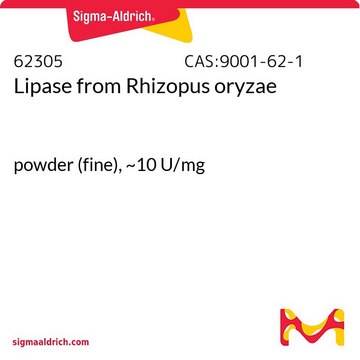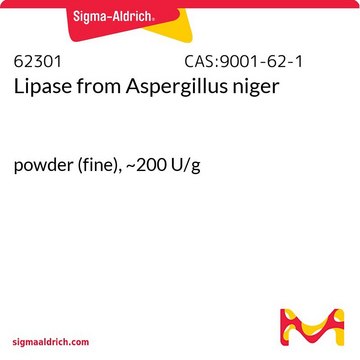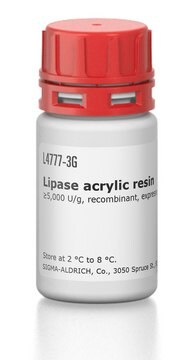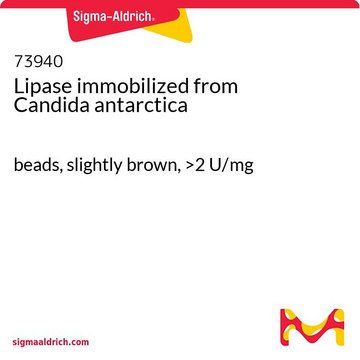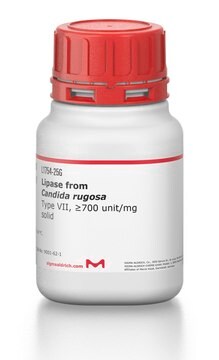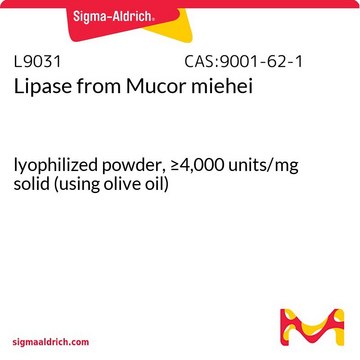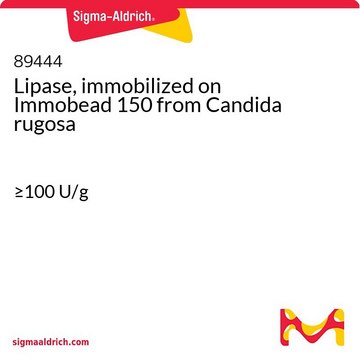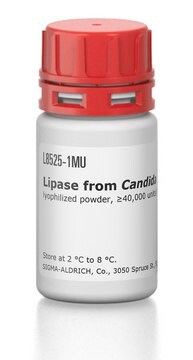80612
Lipase from Rhizopus oryzae
powder, light brown, ≥30 U/mg
Sinónimos:
Lipase F-AP 15
Iniciar sesiónpara Ver la Fijación de precios por contrato y de la organización
About This Item
Productos recomendados
origen biológico
fungus (Rhizopus oryzae)
Formulario
powder
actividad específica
≥30 U/mg
color
light brown
temp. de almacenamiento
2-8°C
InChI
1S/C11H9N3O2.Na/c15-8-4-5-9(10(16)7-8)13-14-11-3-1-2-6-12-11;/h1-7,16H,(H,12,14);/q;+1/b13-9-;
Clave InChI
QWZUIMCIEOCSJF-CHHCPSLASA-N
Descripción general
Research Area: CELL SIGNALING,Rhizopus oryzae lipase (ROL) is a protein synthesized in a precursor form that includes a 26-amino acid presequence, followed by a 97-amino acid prosequence attached to the N-terminal of a mature sequence consisting of 269 amino acids. ROL possesses four potential N-glycosylation sites and is characterized by nine α-helices and eight β-strands, resulting in a molecule stabilized by three disulfide bonds between residues 29–269, 40–43, and 235–244. Lipases are widely distributed in various living organisms, including animals, plants, and microbes.
Aplicación
Lipase from Rhizopus oryzae has been used:
- to replace rabbit gastric extract for infant in vitro digestion
- in the two-phase lipase-catalyzed system for the enzymatic preparation of biodiesel
- in the simulation of infant gastrointestinal digestion in vitro, focusing on the characteristics of emulsions during digestion to replicate the stomach environment and adjust the emulsion pH
Acciones bioquímicas o fisiológicas
Lipases play a crucial role in catalyzing the breakdown of ester bonds of triglycerides at the interface between aqueous and oily layers. The lipase produced by Rhizopus species is known for its suitability in various industrial applications. In industrial settings, lipases of microbial origin are commonly extracellular and are produced during the fermentation process. The utilization of lipases has been shown to be more effective than traditional chemical syntheses in industries such as pharmaceuticals, cosmetics, oleochemicals, detergents, and fragrances.
These enzymes are widely used to modify the structure of oils and fats, tailoring natural lipids to meet specific properties useful for food, nutrition, and cosmetic applications. Lipases from filamentous fungi families, such as Rhizopus oryzae are extensively utilized in the oil and fats industry due to their high 1,3-regioselectivity toward triglycerides, making them versatile in lipid modification. Lipases are used industrially for the resolution of chiral compounds and the transesterification production of biodiesel.
These enzymes are widely used to modify the structure of oils and fats, tailoring natural lipids to meet specific properties useful for food, nutrition, and cosmetic applications. Lipases from filamentous fungi families, such as Rhizopus oryzae are extensively utilized in the oil and fats industry due to their high 1,3-regioselectivity toward triglycerides, making them versatile in lipid modification. Lipases are used industrially for the resolution of chiral compounds and the transesterification production of biodiesel.
Definición de unidad
1 U corresponds to the amount of enzyme which releases 1 μmol fatty acid from triglycerides per minute at pH 7.2 and 37 C (olive oil as substrate)
Nota de análisis
enzyme activity:
the optimum temperature is 40°C, the optimum pH is 7.2 (highly active from pH 6.5-7.5)
the optimum temperature is 40°C, the optimum pH is 7.2 (highly active from pH 6.5-7.5)
Palabra de señalización
Danger
Frases de peligro
Consejos de prudencia
Clasificaciones de peligro
Resp. Sens. 1
Código de clase de almacenamiento
11 - Combustible Solids
Clase de riesgo para el agua (WGK)
WGK 1
Punto de inflamabilidad (°F)
Not applicable
Punto de inflamabilidad (°C)
Not applicable
Equipo de protección personal
Eyeshields, Gloves, type N95 (US)
Elija entre una de las versiones más recientes:
¿Ya tiene este producto?
Encuentre la documentación para los productos que ha comprado recientemente en la Biblioteca de documentos.
Los clientes también vieron
Malgorzata Teodorowicz et al.
Molecular nutrition & food research, 65(8), e2000834-e2000834 (2021-02-10)
β-lactoglobulin (BLG) is a major cow milk allergen encountered by the immune system of infants fed with milk-based formulas. To determine the effect of processing on immunogenicity of BLG, this article characterized how heated and glycated BLG are recognized and
Marit Navis et al.
Nutrients, 12(11) (2020-11-08)
Human milk is the optimal diet for infant development, but infant milk formula (IMF) must be available as an alternative. To develop high-quality IMF, bovine milk processing is required to ensure microbial safety and to obtain a protein composition that
Michael Thomas Zumstein et al.
Environmental science & technology, 51(13), 7476-7485 (2017-05-26)
Biodegradable polyesters have a large potential to replace persistent polymers in numerous applications and to thereby reduce the accumulation of plastics in the environment. Ester hydrolysis by extracellular carboxylesterases is considered the rate-limiting step in polyester biodegradation. In this work
Dean Brady et al.
BMC biotechnology, 8, 8-8 (2008-02-02)
Enzymes have found extensive and growing application in the field of chemical organic synthesis and resolution of chiral intermediates. In order to stabilise the enzymes and to facilitate their recovery and recycle, they are frequently immobilised. However, immobilisation onto solid
Nuestro equipo de científicos tiene experiencia en todas las áreas de investigación: Ciencias de la vida, Ciencia de los materiales, Síntesis química, Cromatografía, Analítica y muchas otras.
Póngase en contacto con el Servicio técnico